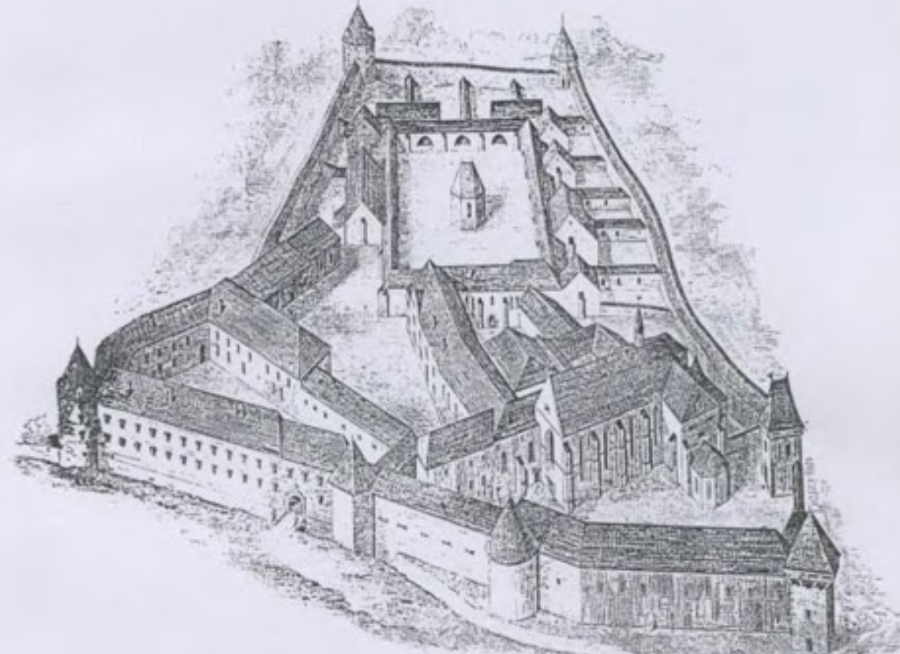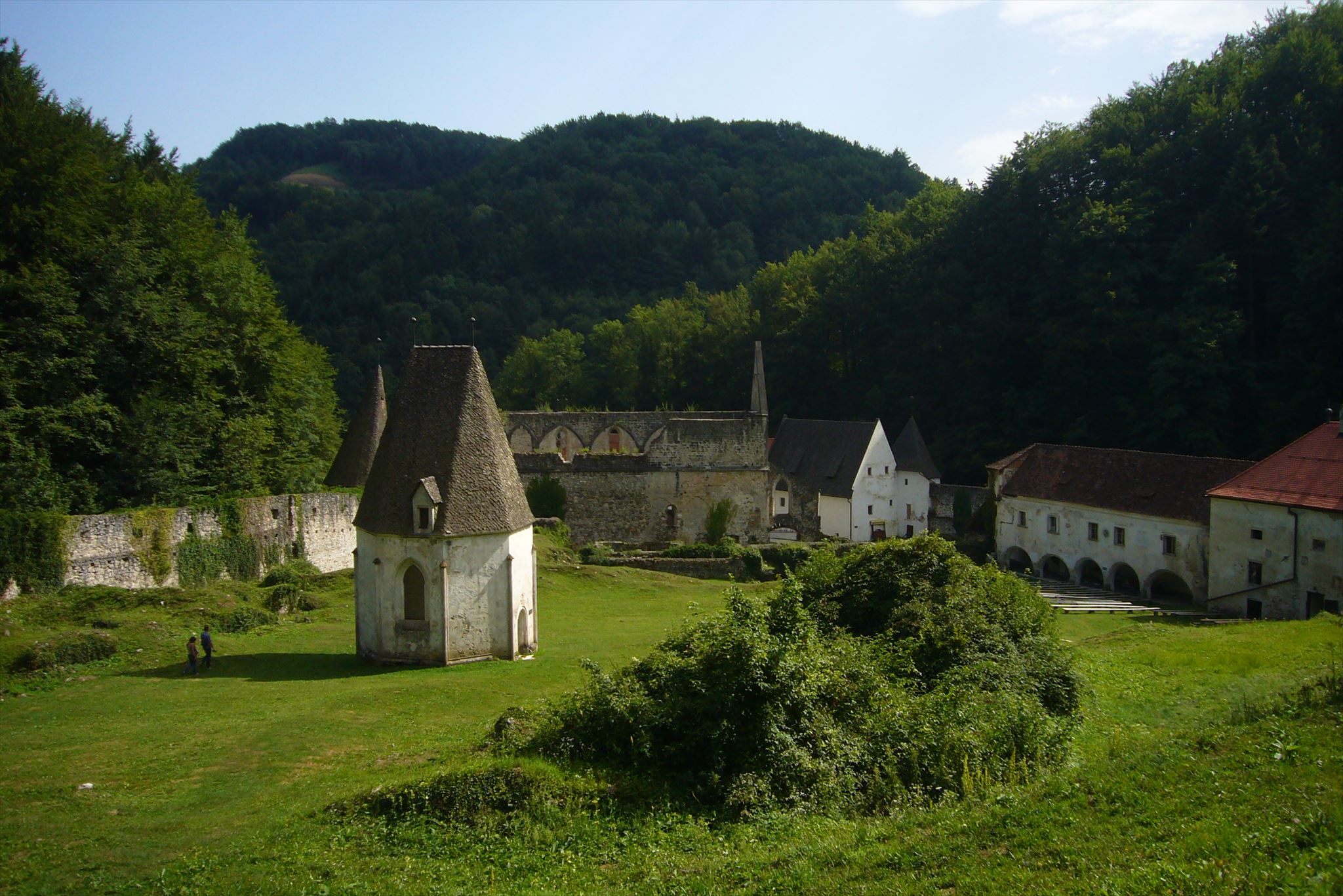Slovenščina
I can not provide a good translation in Slovene. The Slovene page on wikipedia about the Žička kartuzija seems very complete (see
[1.1]). If any Slovene wants to provide a translation in Slovene concerning the summarized information I will provide here in English I would gladly add it.
English
The
Žička kartuzija (Žiče Charterhouse) was a Carthusian monastery in the narrow valley of Žičnica Creek, also known as Saint John the Baptist Valley (Slovene:
dolina svetega Janeza Krstnika) after the church dedicated to John the Baptist at the monastery near the village of Žiče
[1.2].
History
The charterhouse was founded between 1155 and 1165 by the graf Otokar III of Styria and his son Otokar IV of Styria of the house of Trangau, both of whom were buried there. It is one of the oldest Chartusian monastery in central Europe, being the first in the German sphere of influence of the time, and the first outside France and Italy.
[1.1][1.2] The monastery was settled by Chartusian monks from the Grande Chartreuse in France. As with French charterhouses two monasteries were build there: the
lower monastery in the village of Špitalič where the lay monks were residing (it is known that located here was also the “hospital” after which the village Špitalič got his name); and the
upper monastery, the
Žička kartuzija, where 12 cloister monks lived according to the strict rules of the Chartusians.
[1.2][2][3] The monastery church dedicated to Saint John the Baptist was consecrated on 24 October 1190 by Patriarch Berthold of Aquileia.
At the time of the Great Schism in the western Roman Catholic church in the 14th century, the Žiče Charterhouse became the seat of the Prior General of the Carthusian order for a while in 1391.
The monastery was attacked during an Ottoman raid in 1531. This marked the beginning of a decline in its influence and fortunes. In 1564 it passed into the hands of commendatory abbots and in 1591 to the Jesuits of Graz. It was recovered by the Carthusians in 1593, after which it prospered again. In 1782 Emperor Joseph II abolished the monastery, one of the earliest to be dissolved under the Josephine Reforms.
The charterhouse was allowed to fall into decay. The ruins were bought from the religious foundation in 1826 by Prince Weriand of Windisch-Graetz and remained the property of this family until the end of World War II. Now the owner is the Municipality of Slovenske Konjice.
[1.2]
Legend
The following legend is a pseudoetymology of the monastery name. When the Margrave of Styria Ottokar III returned from the Second Crusade, he wished for some relaxation and therefore visited Leopold from Gonobitz to go hunting on Mount Konjice (Slovene:
Konjiška gora). Coincidentally he came to a shady hollow in the south part of the mountain, where suddenly an extremely white hind appeared in front of him. He followed it as bewitched on his horse, but because he was not able to catch it he fell asleep in the shade on the hot summer afternoon (on St. John the Baptist's day). A man in a white fur coat appeared in his dream and revealed himself as St. John the Baptist, ordering him to build a monastery on this place. At that moment a rabbit jumped into Ottokar's lap because it was frightened by the hunter's screaming. The saint's image disappeared and Ottokar shouted: "A rabbit, look, a rabbit!" Because of this rabbit the monastery was called "Seiz Charterhouse" (the Slovenian pronunciation of rabbit,
zajec, is written Seiz in German) for a long time and has the initial "S" in its coat of arms.
[1.2][3][4][5]
Main Buildings

Žička kartuzija in the second half of the 17th century
[6]Gastuž
The
Gastuž is the oldest inn in Slovenia dating from 1467
[1.1][2] and said to be one of the oldest active inns in Central Europe
[3][4], which still holds medieval recipes in its collection.
The
Gastuž is found just outside the charterhouse. It was erected in the 15
th century with the purpose to take care of travellers and guests, after the
lower monastery, where originally they took care of them, was devastated by the Turkish.
[3]
Great monastic church of St. John the Baptist
Great monastic church of St. John the Baptist, after whom a valley is now called, is a single-aisled hall. At the first glance it gives a sense of Gothic building and is only a big ruin nowadays. A number of structural features suggest that the church is Romanesque in its essence. Romanesque building from first era of Charterhouse was heavily rebuild in Gothic era to adapt it to new style as well to practical needs. According to sources from 14
th century the repairs were essential. In addition to the main entrance if the western façade, which is now completely demolished, a great church also had two entrances on the north side. The first entrance from the west wall was for order monks, which also had a separate room in the west part of the church. Into the eastern part of the church, where also altar was located, priests were entering through special entrance straight from small cloister.
[2]
Small cloister
Small cloister which on north side leans on the church is rectangular-shaped and was connecting together individual common places located against it. Of original, romanesque-style cloister, we know only that it had the same ground plan as gothic cloister has today, because all frame walls show romanesque particularities but its architecture is unknown. It is concluded that the cloister was made from wood, maybe even until gothic reconstruction. Located at the easter part of corridor, next to church as it was practice also in other charterhouses, was a Chapter Hall, which is a kind of chamber, where monks (at the beginning there was twelve of them) gathered under the leadership of prior and consult.
[2]
Big cloister
It was a big rectangular place with the lawn in the middle and surrounded by covered corridor, around which the 12 cells were located as individual and visually completely separated houses with small garden inside defence wall. Each cell had entrance only from cloister, and a small window closed with small doors through which monk was getting food and everything else essential for living. Even the oldest rules of Carthusian order specify that monk cannot leave his cell, his main task was to be in peace an solitary of his cell.
Completely preserved cemetery chapel with year 1469 carved above sun dial declares in 15
th century and is a real treasure of mature Gothic architecture.
In the middle of former big cloister, probably south from chapel, a cemetery for all members of order was located. Each grave was marked only with a wooden cross with no name, because carthusians are buried amongst equal. Only prior's grave was marked with his monastic name on the cross.
[2]
Library and the Žiče manuscripts
The monastery became a centre of culture and politics in its territory and far beyond. The Carthusian Prior General from Žiče, Stephen Maconi, a friend of Saint Catherine of Siena connected the politically and ecclesiastically divided continent of Europe from this place. In the 14
th century the monastery had a library of over 2,000 volumes (mostly manuscripts) which was larger than all but the Vatican library.
[1.2][3] Currently, there are only a tenth part of these manuscripts.
[1.1]. The most part of this literary treasure is now conserved in Viena.
[5]
The library was located at the first floor of the Ottokar's chapel.
[2]
The Carthusian order never preached religion through the spoken word, but took to spreading it in writing, accepting into the order only people with a good knowledge of foreign languages (mostly German, Latin, and Greek) and exemplary writing skills. They devoted a large part of their lives to producing precise copies of existing texts as well as creating new ones on a wide range of topics, from theology to astronomy, from practical sciences to those more literary in nature. Among the texts still in existence are many notable works which are part of the intellectual heritage of this region and the wider Middle-European sphere.
[1.2]
...and more
And also refectory, kitchen, cellars, the floor wing, fish tower, the defence walls and towers in the north, the gardens rich in medicinal herbs (one of the oldest pharmacies was located here), are also among the important buildings in the monastery.

Žička kartuzija seen from the north. Image: SastRe.O
Access and visiting hours
The Monastery is accessible by car either taking the A1/E57 and the exit direction to Dramlje/Šentjur and from there taking the road 686 and following the indications; or a little longer but recommended (better road), also in the A1/E57, take the exit direction to SI. Konjice/Poljčane/Zreče, and also follow the road 686 through the villages of Draža vas, Žiče and the monastery.
The visiting hours are as following
[3]:
| April – October | TUE – SUN | 10:00 – 18:00 |
| November | TUE – SUN | 10:00 – 16:00 |
| December – March | TUE – SUN | 10:00 – 16:00 |
Check the references to have updated information in case the visiting hours change!!
I
strongly recommend the audio guide.
References
[1.1] https://sl.wikipedia.org/wiki/Žička_kartuzija
[1.2] https://en.wikipedia.org/wiki/Žiče_Charterhouse
[2] http://www.gradovi.net/
[3] http://tic.konjice.si/
[4] Informative flyer given in the museum
[5] http://www.gremoven.com/
[6] http://www.zupnija-cresnjice.net/